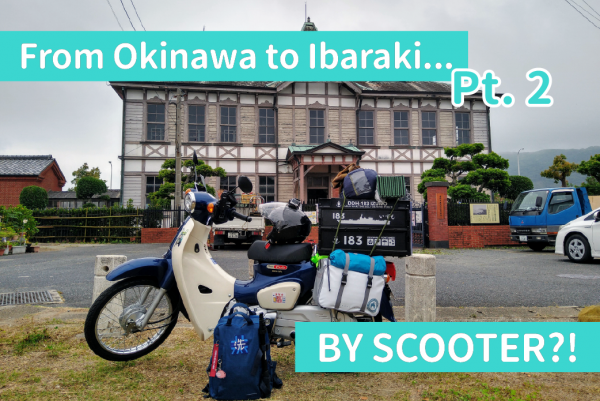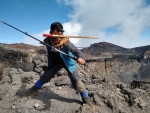Singaporean guy travels 2,300km from Okinawa to Ibaraki by scooter (Part 2)

Welcome back to #WanderfulWednesday. This is Part 2 of my crazy scooter trip across Japan—if you’re new, go on and check out Part 1 first!

My journey north through Japan’s southern island of Kyushu (九州) was to take me through the islands and peninsulas of Kumamoto (熊本) and Nagasaki (長崎) over on the west side. This part of Kyushu is rarely featured in mainstream tourism channels, and hardly on anybody’s radar when it comes to potential getaway locations. As someone who relishes every opportunity to go off the beaten path, I was very eager to check out all its wonders for myself.
The thousand-mile journey begins with a single step


(Image credit: Ananda Kang)
I punched in my destination coordinates on Google Maps, bid one last farewell to Sakurajima, and took off. My journey had officially begun.
“All the way to Ibaraki, huh? That’s far!” Somewhere in the outskirts of Kagoshima, while stopped at a red light, I heard a remark from behind. I looked back to see a middle-aged man on a scooter waiting behind me. It seemed he was referring to the sign I had put up at my rear.
“Yes! Today’s the first day of my journey!” I replied cheerfully.
“How long do you think you’ll take?” He asked.
“About two weeks, maybe slightly more,” I answered.
My itinerary had been somewhat haphazardly planned: based on a very rough estimate of covering 200km per day I could only make calculated guesses as to which city I’d be spending the night in each day. At this rate, I was likely to complete my journey in 16 days.
The light turned green, signalling the end of our conversation. “I see. Well, good luck to you!”
“Thank you, I’ll do my best!”
I did not know it at the time, but that was the first of many friendly interactions on the road to come.

(Image credit: Ananda Kang)
It was not long before I crossed the city limits. Clusters of tall buildings eventually gave way to breathtakingly beautiful rural landscapes of the countryside and nature.
The land of heavenly grass

(Image credit: Ananda Kang)
I arrived in Minamata City (水俣市) a couple of hours later and settled down for the night, before continuing my journey the next morning. Another hour of riding later I pulled up at Kuranomoto (蔵之元), a port town on the northern side of Nagashima (長島). I snapped some photos of the surroundings while waiting for a ferry.

(Image credit: Ananda Kang)
The ferry took me and my scooter across the Shiranui Sea (不知火海 Shiranui-kai), the inland sea that separates the western Amakusa Islands (天草) from the main island of Kyushu. It was a little rainy but the view of the Shiranui Sea along the way was nevertheless spectacular.

(Image credit: Ananda Kang)
I came ashore to Amakusa in the town of Ushibuka (牛深) and started my tour around the island. Small clusters of buildings amidst mountains and seas made for picturesque views. Stunning scenery surrounded me every step of the way as I weaved through the hilly coastal roads.

(Image credit: Ananda Kang)
Amakusa was one of the flashpoints of the Shimabara Rebellion, a time of unrest instigated by discontented Christians during the Edo Period (1603-–1868). Following this uprising, Christianity in Japan became repressed and many worshippers in the region continued practising their religion in secret as Kakure Kirishitan (隠れキリシタン) until the Meiji Period. The numerous historic architecture of Amakusa such as Sakitsu Church (カトリック﨑津教会 Katorikku Sakitsu Kyōkai), Oe Tenshudo Church (大江天主堂), and Tomioka Castle (富岡城 Tomioka-jō) all do a fine job in preserving the region’s storied past.
Sakitsu Church (カトリック﨑津教会)
Address: 539 Kawauramachi Sakitsu, Amakusa-shi, Kumamoto 863-1204
Nearest bus station: Sakitsu Kyokai Iriguchi
Opening hours: 8:30am–5pm (Closed on Mondays)
Admission fee: Free
TEL: +81 969-78-6000
Oe Tenshudo Church (大江天主堂)
Address: 1782 Amakusa-machi Oe, Amakusa-shi, Kumamoto 863-2801
Nearest bus station: Oe Tenshudo Iriguchi
Opening hours: 9am–5pm (Closed on Mondays)
Admission fee: Free
TEL: +81 969-22-2243
Tomioka Castle (富岡城)
Address: 2240 Tomioka, Reihoku-machi, Amakusa-gun, Kumamoto 863-2507
Nearest bus station: Ichichome Bus Stop
Opening hours: 9am–5pm (Closed on Wednesdays)
Admission fee: Free
TEL: +81 969-35-0170
Writer’s note: While the nearest train station is Misumi Station, you’ll have to take the bus to get to these locations as there are no trains on Amakusa.
Shimabara, a story of rebellion

(Image credit: Ananda Kang)
Nighttime was slowly creeping up on me, so I sped off northeast to bed down in Kumamoto City. The next day, I hitched yet another ferry ride across the Ariake Sea to reach Shimabara (島原), Nagasaki. Just like Amakusa, it too bears significant religious history.

(Image credit: Ananda Kang)
Shimabara Castle (島原城 Shimabara-jō) in Shimabara City (島原市) boasts an imposing Tenshu (天守 main keep of the castle), with several relics and artefacts on display alongside modern art sculptures.

(Image credit: Ananda Kang)
In the middle of the Shimabara Peninsula lie the mountains of Unzen (雲仙), a geothermally- heated hot spring nestled amidst its heights. Unzen was the site of cruel Christian persecution in the Edo Period, but on a happier note, Unzen Onsen is also the first national park ever designated in Japan. Plenty of onsen resorts dot the area, and thick steam smelling of sulphur and acid billow out from the rocky Jigoku (地獄 hell) springs.
Shimabara Castle (島原城)
Address: 1-1183-1 Jonai, Shimabara-shi, Nagasaki 855-0036
Nearest station: Shimabara Station (島原駅)
Opening hours: 9am–5:30pm
Admission fee: ¥550 (Adult), ¥280 (Elementary/Middle/High School Student)
TEL: +81-957-62-4766
Unzen Onsen/National Park (雲仙温泉)
Address: Obamacho Unzen, Unzen, Nagasaki 854-0621
Nearest station: Isahaya Station (諫早駅) (Take the Shimatetsu Bus to Unzen Shimatetsu Bus Office)
Opening hours: 24 hours
TEL: +81-957-73-3636
Nope, no zombies here

(Image credit: Ananda Kang)
Continuing northwards, I crossed the border into Saga Prefecture (佐賀県 Saga-ken) on the evening of the third day, arriving at the city of Ureshino (嬉野) which is well-known in the region for its green tea and onsen resorts. The spring waters here are high in sodium content and feel silky smooth to the skin, giving rise to its famous moniker “Bihada no yu” (美肌の湯 beautiful skin baths). Being able to soak in a rejuvenating hot bath to soothe my sores was a much-needed respite.

(Image credit: Ananda Kang)
I left Ureshino and continued deeper into Saga. Along the way I stopped by to take in another spectacular view of terraced rice fields, this time at Hamanoura (浜野浦).
My cardinal direction eventually shifted from north to east. After a brief but harrowing ride through a stretch of twisting mountainous road in near pitch-darkness, I exited the country landscape to find my surroundings gradually filling with buildings and urban sprawl. I had crossed into Fukuoka Prefecture and arrived in Fukuoka City (福岡市 Fukuoka-shi).
My stay in the city was brief. Itching to be out in the boondocks once more, I made for the edge of town on the northeast the next day.

(Image credit: Ananda Kang)
In between Fukuoka and Kitakyushu I came upon Miyajidake Shrine (宮地嶽神社 Miyajidake-jinja) in Munakata City (宗像市 Munakata-shi), famous for the dreamy sunset scenery seen from the top of a flight of stairs.
Ureshino Onsen Information Center (嬉野温泉観光協会観光案内所)
Address: 2202-55 Shimojukuotsu, Ureshino-cho, Ureshino, Saga 843-0301
Nearest station: Sonogi Station (彼杵駅) (Take the bus to Ureshino Hot Spring Bus Station)
Opening hours: 9am–6pm
TEL: +81-954-42-0336
Terraced Rice Fields of Hamanoura (浜野浦の棚田)
Address: Hamanoura, Genkai, Higashimatsuura-gun, Saga 847-1433
Nearest station: Nishi-Karatsu Station (西唐津駅) (Take the bus to Hamanouranotanada Bus Station)
Opening hours: 24 hours
Miyajidake Shrine (宮地嶽神社)
Address: 7-1 Miyaji Motomachi, Fukutsu, Fukuoka 811-3309
Nearest station: Fukuma Station (福間駅) (Take the bus to Miyajidake Jinja-Mae Bus Station)
Opening hours: 9am-5pm
Admission fee: Free
TEL: +81-940-52-0016
Next stop, Honshu

(Image credit: Ananda Kang)
Arriving at Kitakyushu meant that the Kyushu leg of my trip was coming to an end. I had already traversed 835km over six days at this point. To celebrate this milestone, I treated myself to some fantastic views of the historic port town of Moji (門司).

(Image credit: Ananda Kang)
At one of the many observation decks of Mekari Park (和布刈公園), gazing past the Shimonoseki Strait over the Kanmon Bridge (関門橋 Kanmon-kyō), I beheld the landmass that was to be the next leg of my momentous journey.
Honshu was calling out to me.
Mojiko Retro (門司港レトロ)
Address: 9 Minatomachi, Moji-ku, Kitakyushu, Fukuoka 801-0852
Nearest station: Mojiko Station (門司港駅)
Opening hours: 24 hours
TEL: +81-933-21-4151
Mekari Park (和布刈公園)
Address: 2 Kyumoji, Moji-ku, Kitakyushu, Fukuoka 801-0854
Nearest station: Kanmonkaikyo Mekari Station (関門海峡めかり駅)
Opening hours: 24 hours
TEL: +81-933-31-1881
Header image credit: Ananda Kang





